Mobile applications are in higher demand than ever before. In 2019, mobile users downloaded 204 billion of them, spending $120 billion (State of Mobile 2020, AppAnnie).
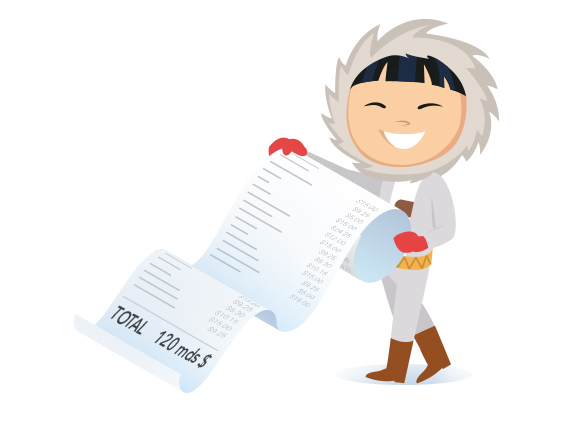
In this context, it makes sense to want to launch a mobile app of your own. There is, however, one (major) issue: the two main Stores offer over 6 million apps, 3.6 million on Google Play, and 2.7 million on the AppStore, respectively. Needless to say, the competition is fierce, and the stores continue to step up their demands as the number of candidates goes up. And yet, users can’t download an app they can’t see…
This is where mobile app optimisation – also known as App Store Optimisation (ASO) – comes into play. The process aims to optimise an app to maximise its visibility, increase the number of clicks, and boost the download rate, all while attracting qualified users who won’t just uninstall it a few days later. These are the foundations of any Mobile Growth strategy.
Similar to search engine optimisation for websites, App Store Optimisation (ASO) is used to improve a mobile app’s rank on the app stores – namely on the most important ones, Apple’s and Google’s. Let’s delve deeper into the world of mobile optimisation and discover the main ranking factors for mobile applications through our complete App Store optimisation guide.
App Store Optimisation (ASO) VS. Search Engine Optimisation (SEO): What Difference?
The ASO/SEO comparison makes a lot of sense as both approaches share a common goal (improving visibility in the search results) and are based on keywords. As for the rest, ranking factors are different. For instance, SEO pays attention to bounce rate, whereas ASO looks at an app’s uninstall rate; the former considers the pages’ loading time, while the latter is more interested in its uses. In addition, the list of App Store Optimisation (ASO) levers is much shorter than that of SEO (about 10 vs. over 200).
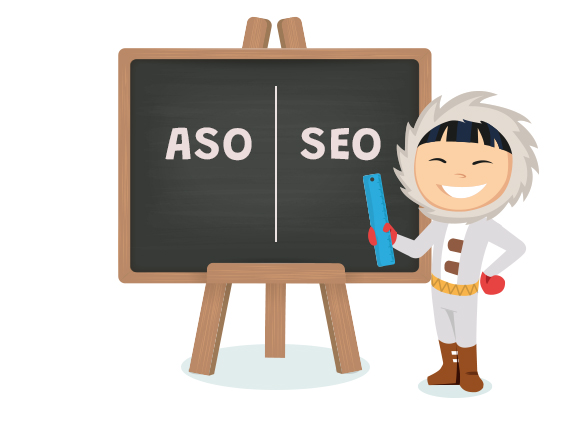
One of the main discrepancies between these approaches resides in the purposes of the process. In search engine optimisation, the end game is to generate traffic. When it comes to App Store Search Optimisation, however, traffic is only one side of the coin. The other is conversion – meaning how many downloads the app is able to generate. Once the app is visible on a Store, it remains a challenge to get the user to install it on their phone (whether they need to purchase it or not, depending on the business model) and to use it – two factors which are essential to App Store Optimisation (ASO).
The Main Stores: AppStore and Google Play
The App Store Optimisation (ASO) process requires an in-depth knowledge of how app stores work. Let’s look at the two most significant actors on the market, who generated a cumulated revenue of $40 billion in 2019 (SensorTower).
- The AppStore is Apple’s mobile application store. Historically, this was the first one ever created, as it was launched at the same time as the iPhone 3G back in 2008. Eleven years later, the number of iOS apps available went from 800 to 2.7 million.
- Google Play is the app store dedicated to Android devices. Its launch, in 2012, stemmed from a will to bring together several Google services (Movies, Music, Ebookstore) and the Android Market. The store is intrinsically connected to the Google ecosystem.
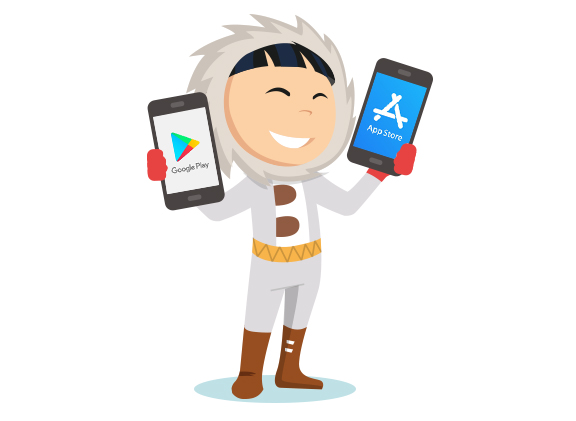
Both stores share the same objective, which is to give users access to the mobile apps created by first-party or third-party developers. Yet, each one uses its own proprietary algorithm to rank the applications. App Store Optimisation (ASO) levers don’t all work the same way, even though most of them are found on both platforms.
This means one thing: Optimizing your app on both Stores implies that you need to know and apply a certain number of potentially distinct rules. But before we go any further into these criteria, let’s first try and understand App Store searches.
How do users find interesting mobile apps?
Mobile Internet users have a very specific way of looking for applications on app stores. 75% of them seek out a specific app, usually using the Store’s internal search engine. A minority of them use rankings and “featured apps”.
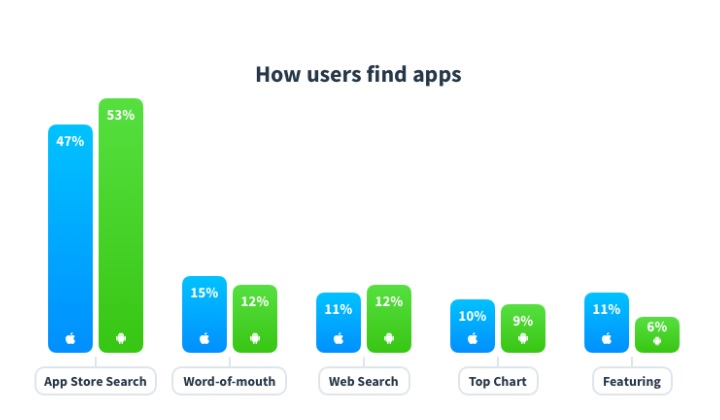
Their search could involve the name of the app or the brand that produced it, or it could be a generic search corresponding to a specific need (for example, “notepad” or “weather”). This gives us an indication as to why keywords are so important in the App Store Optimisation (ASO) process.

What happens once they’ve found the application? Its ranking impacts its download potential. The higher the app appears in the results, the better its chances are of being downloaded – keeping in mind that the average user looks at the first 5 results. In turn, the number of downloads has an influence on the app’s ranking, thus creating a virtuous cycle.
Now that we have wrapped our minds around these principles, let’s dive right into the topic.
App Store Optimisation (ASO): the ranking factors
The main App Store Optimisation (ASO) factors are the same on the AppStore as they are on Google Play:
- Keywords
- Title/Name of the app
- App description
- Category in which the app is referenced
- App’s visuals
- Update frequency
- Number of downloads
- Number of active users
- User ratings and reviews
- Quality of the app

In the following sections, we will address the differences that exist in terms of App Store Optimisation (ASO) and highlight the right practices when optimising an app for every factor.
KEYWORDS
As is the case in Search Engine Optimisation, keywords are a cornerstone of App Store Optimisation (ASO). It’s a question of identifying, and then working on the keywords Internet users type in the most when they want to find apps, by adding them to the relevant fields.
You need to select the keywords for which you want your app to be found. For example, “novelty bracelets” for an app that sells these types of accessories.
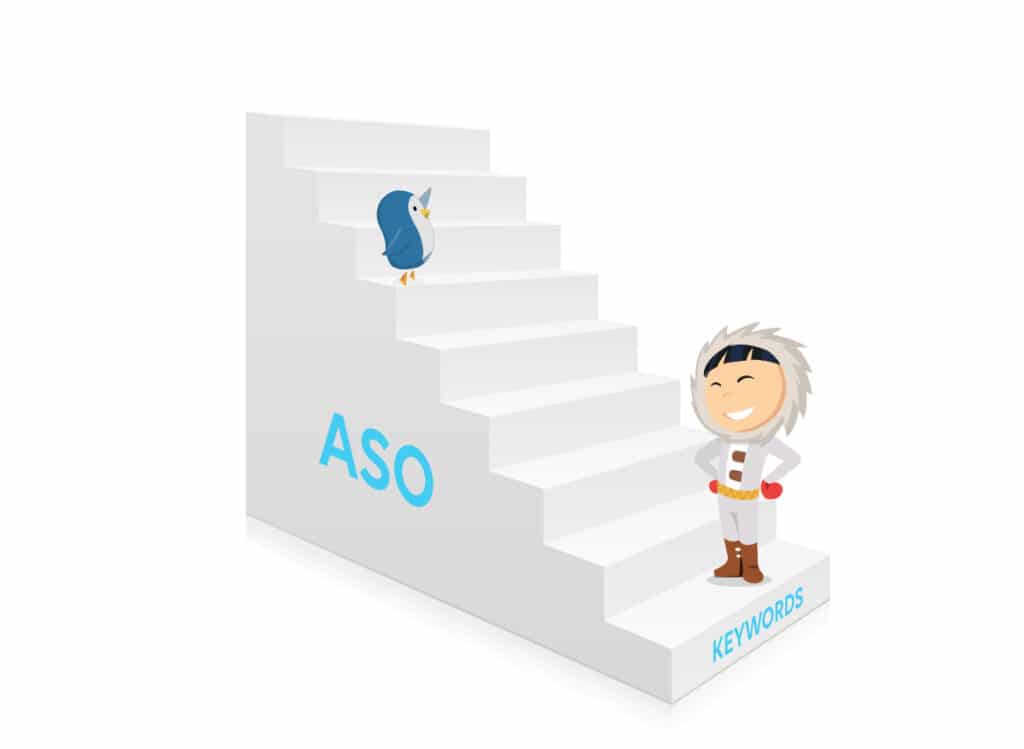
Although keywords are essential when optimizing an app on either of the Stores, they are not measured in the same way.
- The AppStore has a specific field dedicated to keywords. Write the ones you want your application to appear for in the search results. By default, the Store can draw from the terms used by the competition, or just use the name of the category. Note that it is not necessary to repeat keywords multiple times within a given field.
- Google Play works more or less the same way as Google’s search engine: The algorithm considers all the text elements from indexing the application. Don’t hesitate to repeat the keywords several times in the same field.
In both cases, the name of the developer or editor must be given for the sake of transparency, as well as to boost the application’s ranking.
In the context of App Store Optimisation (ASO), such tools as Google Keyword Planner are enough to facilitate your keyword research. To go further, there exist paid solutions such as AppAnnie or Mobile Action. You can also get your inspiration from the category in which your app is displayed, from its functionalities, use synonyms of the most searched keywords, etc.
As is the case with SEO, it’s best to refrain from using keywords that are too competitive. Otherwise, the chances of ranking among the very first results, particularly for a recent application, become very slim compared to the behemoths that monopolise the same category.
TITLE/NAME OF THE APPLICATION
The title/name field is one of the most important levers in App Store Optimisation (ASO). And it doesn’t come as a surprise, since it both defines the identity of your application, and remains the very first thing users get to see when they perform a search. Furthermore, keywords inserted in the title are the ones that matter the most when it comes to App Store rankings.
- On the AppStore, the title should not exceed 30 characters. It is possible to add a subtitle up to 170 characters, though. Needless to say, it is a good idea to take this opportunity to insert more keywords! You can also include a CTA (Call-to-Action) to encourage users to download your app.
- On Google Play, the title should not exceed 50 characters. You can include the keywords as many times as you like.
Make sure your app’s title is relevant, eye-catching, easy to read, understand and memorise, as well as unique. Don’t forget to include the name of the developer or editor.
DESCRIPTION
The description is another crucial piece of metadata for App Store Search Optimisation (ASO). It provides the users with information about the application, its features, and its highlights. The App Store algorithms look at it closely, as this is also where they find those precious keywords.
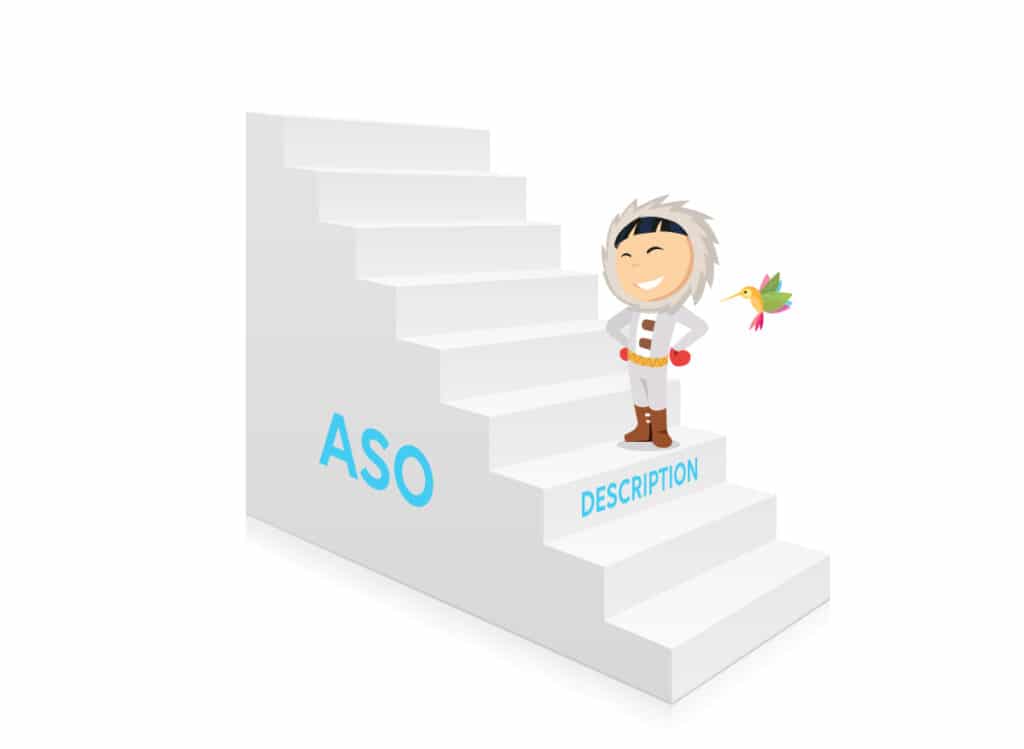
- On the AppStore, plenty of space is provided for the description: up to 4,000 characters. The algorithm doesn’t take keywords from this field into account, but you can still use it to describe the benefits of your application and prompt people to download it.
- On Google Play, there are two descriptions: a short, 80-character one, and a long one which can go up to 4,000 characters. The short one is there to draw the users’ attention by means of a few, well-chosen terms (and, why not, a few emojis), whereas the long one is perfect for explaining the different functionalities and include keywords. Here again, the main point is to encourage downloads.
Since the description is aimed at the users as much as the algorithms, be sure to make it clear and relevant, and only include keywords that can be worked in in a natural way.
VISUALS
Visuals are an integral part of App Store Optimisation (ASO). They fall under two main categories:
- The application’s thumbnail, which is crucial to make users want to find out more. This icon is what draws their attention.
- Screenshots and videos, which play a huge part in making people want to download the app by showing them how it works, using storytelling, etc.
Both stores take a similar approach to this. They allow you to insert a thumbnail, screenshots, as well as videos that serve as an app preview. Offer as many of these as you can to give users information, boost the click through rate and download rate, and get further up the search results.
CATEGORY
An application should be placed in the right category, thus allowing your target audience to assess its relevance based on their own needs. This is another ranking factor when it comes to App Store Optimisation (ASO), since the algorithm uses the information to index your app. For instance, it’s obvious that a weather app that appears in the “health & fitness” category won’t be considered relevant by the algorithm.
The two stores adopt a slightly different stance on this:
- The AppStore allows you to select a main category and a secondary category. Use these two options to make your rankings more relevant.
- The Google Play Store only offers a single category. This means you should put a lot of care and attention into selecting it.
To pick the right category – when it’s not necessarily obvious, for instance, should an app about nutrition be included in the “food” category, or in the “health” category? – just look at it from the users’ perspective: where are they most likely to look if they want to find your app?
UPDATES
To both stores, regular updates are a positive sign, as they mean that your application is evolving and that it still has at heart to satisfy its users. Consequently, updates should always make sense and constitute an improvement – it should never just be about changing a wallpaper!
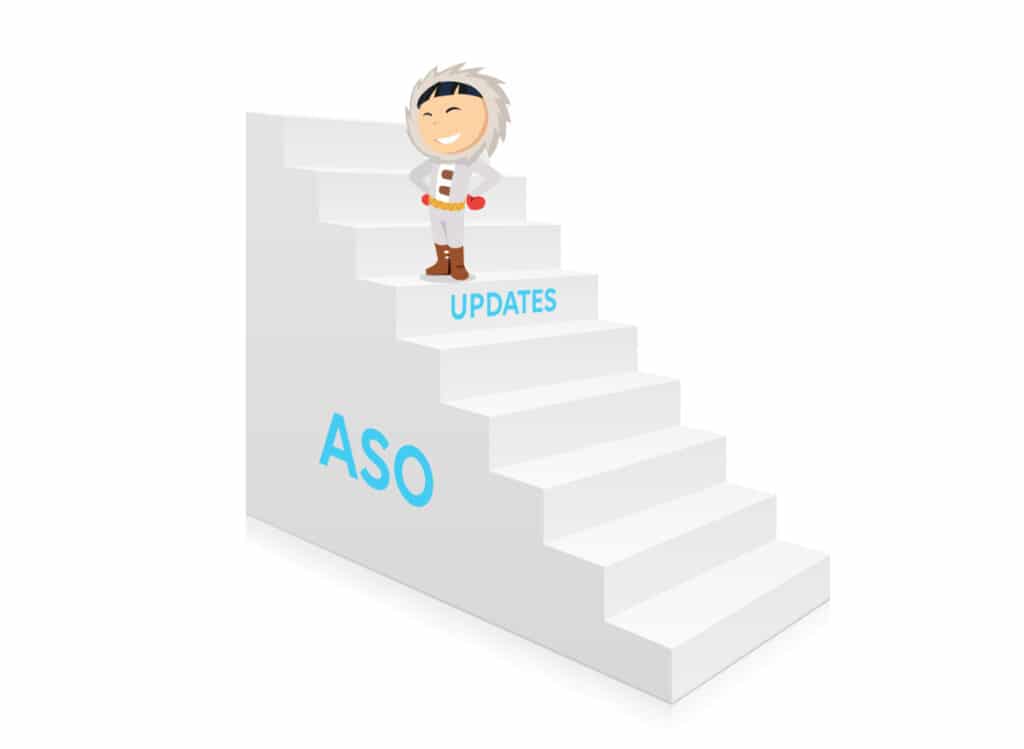
Updates are also an App Store Optimisation (ASO) lever, in that they can be an opportunity to modify metadata and keywords.
NUMBER OF DOWNLOADS AND ACTIVE USERS
Both of these criteria are about user engagement. They are only accessible after you have been present on the Store for a certain amount of time.
- Number of downloads. The more an application gets downloaded, the more the algorithm improves its ranking, and the more visibility it gains… and the more it gets downloaded!
- Number of active users. Downloading an application is one thing. Using it on a regular basis is quite a different one. The algorithms favour apps that show a high number of active users. This is called “retention”, or the ability to retain Internet users once they’ve installed the app on their mobile devices.
Be careful, as algorithms also consider the opposite factor. If an application is often uninstalled, either because it’s not relevant or for technical reasons, it is considered a (very) negative sign. This makes the quality aspect all the more important (see below).
RATINGS AND REVIEWS
User satisfaction plays a major role in how an app in indexed and remains an especially sensitive factor when it comes to App Store Optimisation (ASO).
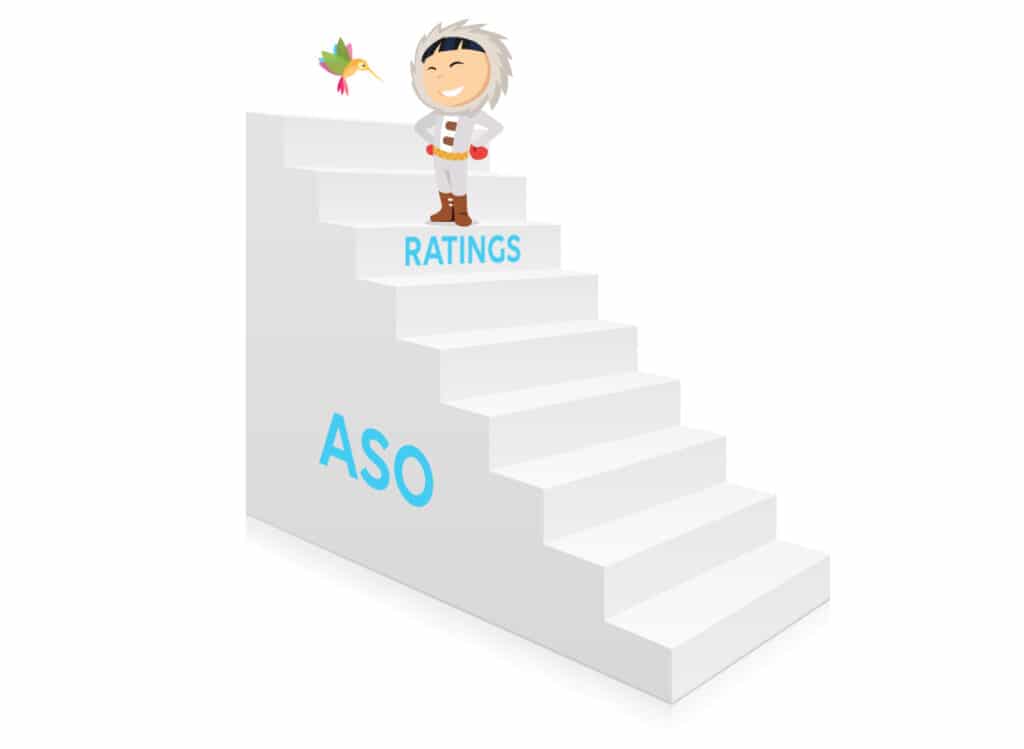
- Ratings are important on both Stores. As the graph below illustrates, only 50% of users say they would be willing to download an app with a 3-star rating (out of 5). The figure falls to 15% for 2-star ratings!
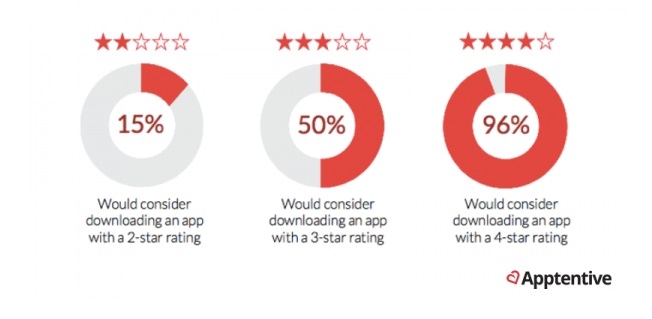
This means good ratings boost the number of downloads, which sends positive signals to the algorithm. On the contrary, bad ratings don’t encourage users to take the plunge.
Reviews have an impact on acquisition. Most users read at least one customer feedback review before downloading an application, all the more so if it’s a paid one. There again, positive comments (or relevant answers to negative comments) influence the number of downloads, and therefore the app’s ranking in the results.
In terms of App Store Optimisation (ASO), it is therefore essential to ask users to rate your app (at the right time, after a few days of use at least) and to leave their feedback. You also need to address any negative comments as quickly as possible.
VISIBILITY ON GOOGLE: A GOOGLE PLAY SPECIFICITY
The Google Play Store has a specificity when it comes to App Store Optimisation (ASO). An app which is organically visible on Google can improve its rankings on the Store.
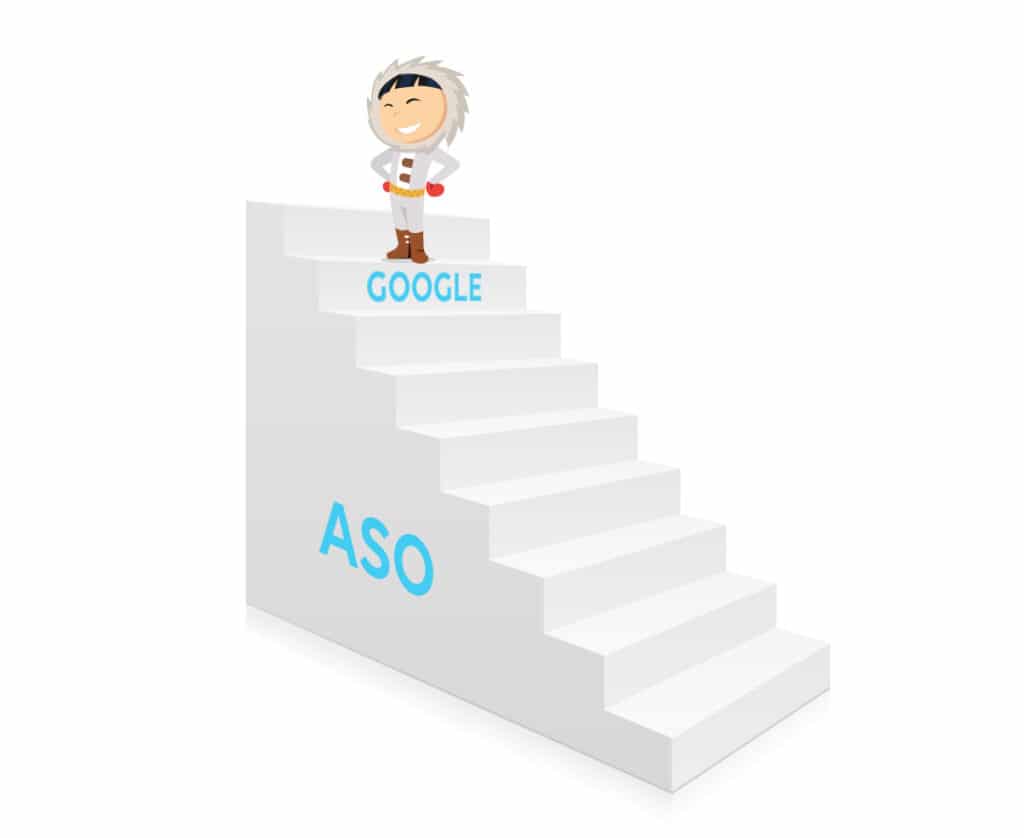
The number of downloads is the main ranking factor: the more visible an app is, the more it gets downloaded, and the more the algorithm deems it relevant. With that said, the search engine, which has some influence on Google Play’s algorithm, can also boost it a little.
QUALITY: AN (OBVIOUSLY) CRUCIAL FACTOR
Finally, should we really stress that one of the most important factors for App Store Optimisation (ASO) is none other than the quality of the application?
It naturally has a strong influence on the number of downloads, on the user ratings, as well as on their reviews. There are several criteria that both Stores’ algorithms take into account to sort through applications and choose which ones deserve higher rankings.
A good-quality application should…
- Correspond to the use for which it was created (providing information, passing the time, interacting with others, finding goods and services…)
- Be easy to use (ergonomic design, clear interface…)
- Innovate when compared to competing apps
- Generate a satisfactory download and retention rate
- Receive regular updates, to correct bugs in particular
- Be technically flawless
This was everything you need to know about App Store Optimisation (ASO)! And with that, you get to implement your very own mobile app optimisation strategy.












